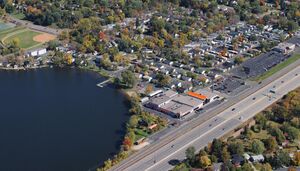
Aaron test MS4 page
The municipal separate storm sewer system (MS4) stormwater program is designed to reduce the amount of sediment and pollution that enters surface and ground water from storm sewer systems. Public entities that own or operate an MS4 play a key role in preventing or reducing the negative impacts stormwater runoff has on our valuable water resources.
Proper stormwater runoff management in urbanized areas is especially important for restoring and protecting surface waters. Urbanized areas are more likely to have activities that contribute pollutants to stormwater runoff, like applying anti/deicing mixtures to roads; fueling vehicles; grease, oil, and other spills; landscaping; and using pesticides and fertilizers. Urbanized areas have a large amount of impervious surfaces, or surfaces that rain and snowmelt cannot pass through, such as streets, driveways, rooftops, parking lots and sidewalks. Stormwater runoff from these surfaces travels faster and in higher amounts, damaging rivers, streams, and wetlands; destroying aquatic habitats; increasing the amount of pollutants that enter surface waters; and limiting groundwater recharge and the MS4 program is to help mitigate the impact.
Contents
Background Information
Regulated MS4 permittees are required to develop a stormwater pollution prevention program (SWPPP) to reduce the pollutants entering the municipality's storm sewer system. When applying for the MS4 permit, permittees identified measurable goals they intended their SWPPP to reach. Based on these goals, permittees should evaluate the effectiveness of their program and make any necessary changes.
- What is a municipal separate storm sewer system (MS4)?
REMOVED CITY OF AUSTIN IMAGE AND LINK ON THE RIGHT, NO LONGER AVAILABLE, ALREADY MOVED YOUTUBE VIDEO FROM THIS PAGE'S OTHER RESOURCES. SHOULD WE REMOVE THE CONTACT INFORMATION FROM THE SIDE? WE HAVE IT DOWN LOW TOO.
- Why is a municipality regulated under the MS4 permit?
DELETE OTHER RESOURCES - PERHAPS THIS CAN BE COMBINED WITH THE WHAT IS AN MS4 LINK ABOVE?
2020 MS4 General Permit
- 2020 MS4 General Permit PDF Version
- 2020 MS4 General Permit Reissuance Page
- 2020 MS4 General Permit Wiki Version
- MS4 Annual Report
MS4 Stormwater Permits (Individual)
Previous Permits
Minimum Control Measures
When seeking to manage a Municipal Storm Sewer System (MS4), an effective Stormwater Pollution Prevention Program (SWPPP) has six different components known as Minimum Control Measures (MCMs).
WENT THROUGH AND CHECKED REDUNDANT AND BROKEN LINKS ON THE TEST MCM PAGES ALREADY - CHECK TO MAKE SURE ANY DELETED PAGES IN "WHAT LINKS HERE" ARE PROPERLY UPDATED TO THE NEW PAGES - I.E. ANY MCM STUFF POINTING TO THE MS4 TOOLKIT ARE UPDATED TO THE LANDING PAGE OR APPROPRIATE MCM
- MS4 documentation required - What should I document under the MS4 Permit?
- Minimum Control Measures 1 - Public Education and Outreach
PAGE NEEDS TO BE UPDATED WITH THE AARON TEST MCM 1 PAGE
- Minimum Control Measures 2 - Public Participation/Involvement
PAGE NEEDS TO BE UPDATED WITH THE AARON TEST 2 MCM PAGE
- Minimum Control Measures 3 - Illicit Discharge Detection and Elimination
PAGE NEEDS TO BE UPDATED WITH THE AARON TEST MCM 3 PAGE
- Minimum Control Measures 4 - Construction Site Stormwater Control
PAGE NEEDS TO BE UPDATED WITH THE AARON TEST MCM 4 PAGE
- Minimum Control Measures 5 - Post-Construction Stormwater Management
PAGE NEEDS TO BE UPDATED WITH THE AARON TEST MCM 5 PAGE
- Minimum Control Measures 6 - Pollution Prevention/Good Housekeeping
PAGE NEEDS TO BE UPDATED WITH THE AARON TEST MCM 6 PAGE
Total Maximum Daily Loads (TMDLs)
Total Maximum Daily Loads (TMDLs) are EPA approved amounts of pollutant loading that can occur and have a water body meet water quality standards. Follow this link to learn more about them along with guidance and resources.
Tools and Resources
CLEANED UP SOME OF THE BLOCK TEXT AND WIDDLED IT DOWN TO A MORE CLEAR AND CONCISE MESSAGE OR REMOVED TEXT ALL TOGETHER BECAUSE TITLE IS SELF EXPLANATORY
- Assessing Total Suspended Sediment and Total Phosphorus Removal Efficiency of Permittee Owned/Operated Constructed Stormwater Ponds: guidance related to assessing the total suspended sediment (TSS) and total phosphorus (TP) removal efficiency of MS4 (Municipal Separate Storm Sewer System) permittee owned/operated ponds constructed and used for the collection and treatment of stormwater.
- Checklist and Maintenance Documents and Examples of Procedures for MS4 BMP Methods
PAGE NEEDS TRANSFERRANCE
- Documentation Requirements and Documents to Retain Under the MS4 Permit
FIXED TABLE ALIGNMENT - PAGE RECOMMENDED TO BE DELETED - ENSURE LINKED ITEMS ARE TRANSFERRED APPROPRIATELY
- MS4 Mapping Tool - An interactive online map tool to view and explore Minnesota MS4 boundaries, defined urbanized areas, impaired waters, outstanding resource value waters, trout waters and approved TMDL study areas.
- New Permit Requirements and Related Guidance Materials
ENSURE LINKED ITEMS ARE TRANSFERRED APPROPRIATELY
- Pollution Prevention Guidance Fact Sheets - A Collection of Minnesota Stormwater Manual Fact Sheets on MS4 Stormwater Pollution Prevention Methods.
MS4 Audit Guidance
The U.S. Environmental Protection Agency (EPA) mandates the Minnesota Pollution Control Agency (MPCA) to evaluate MS4 permittees for compliance with the MS4 General Permit. The MPCA does this through compliance audits. To find out more information about the audit process see the pages below:
- EPA's measureable goal guidance for developing and evaluating a stormwater progarm's goal
- General Stormwater Program Management - Examples for tracking activities in your SWPPP
THIS PAGE HAS BEEN WORKED INTO THE MAIN PAGE AND CAN BE DELETED
- Phase II MS4 Audit Process
- Self-Audit Guidance for Phase II MS4s
MPCA MS4 Technical Assistance
- 2017 MS4 Technical Assistance and Outreach Needs Survey Results
- Green Communities A guidebook for developing clean water projects with Homeowners’ Associations - Washington Conservation District
- MS4 Case Studies
- MS4 Webinars and Videos
- MPCA MS4 Staff Contact Information
- MPCA MS4 Website
Other Resources and Documents
- Acknowledgements to Contributors
PAGE NEEDS TRANSFERRANCE
- MS4 Outreach Photo Library
PAGE NEEDS TRANSFERRANCE
- MS4 Program Overview and Minimum Control Measures (MCM) Descriptions - YouTube Video
- Pond, Lake, and Wetland Inventory
- Stormwater and Wetlands - Planning and Evaluation Guidelines
- Untreated Stormwater Runoff to Lakes, Streams, and Wetlands

